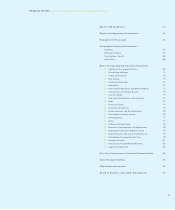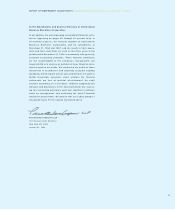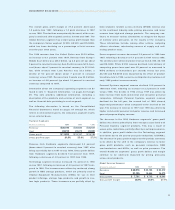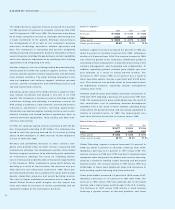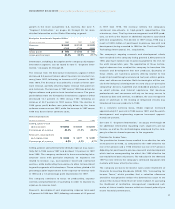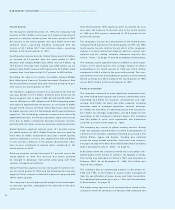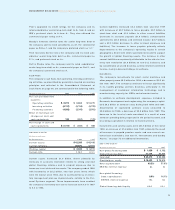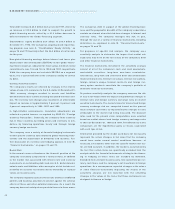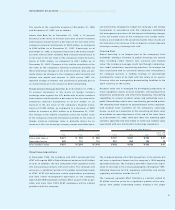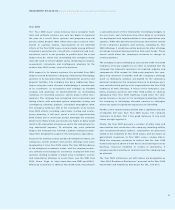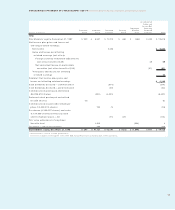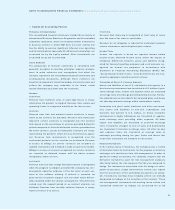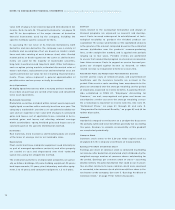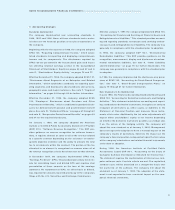IBM 1998 Annual Report Download - page 63
Download and view the complete annual report
Please find page 63 of the 1998 IBM annual report below. You can navigate through the pages in the report by either clicking on the pages listed below, or by using the keyword search tool below to find specific information within the annual report.
61
MANAGEMENT DISCUSSION International Business Machines Corporation and Subsidiary Companies
Total Run Out of 1998 Balance
2002 and
(Dollars in millions) 1996 1997 1998 1999 2000 2001 beyond
Sales-type leases $«471 $««««563 $÷÷685 $«167 $«261 $«226 $«31
Operating leases 480 701 731 291 285 139 16
Total residual value $«951 $«1,264 $«1,416 $«458 $«546 $«365 $«47
Divestitures/Acquisitions
In December 1998, the company and AT&T announced that
AT&T will acquire IBM’s Global Network business for $5 billion
in cash. In addition, the two companies have agreed to enter
into outsourcing contracts with each other. The company will
outsource a significant portion of its global networking needs
to AT&T. AT&T will outsource certain applications processing
and data center management operations to the company.
About 5,000 IBM employees will join AT&T as part of the acqui-
sition and more than 2,000 AT&T employees will be offered
positions with the company.
The company believes that this transaction, in its entirety, will
not have a significant impact on the company’s 1999 ongoing
operational results. The company and AT&T expect the acqui-
sition to conclude in the various geographies throughout 1999,
following clearance by U.S. regulatory authorities and certain
regulatory authorities outside the U.S.
The company awarded AT&T Solutions a contract valued at
$5 billion over five years for a significant portion of the com-
pany’s own global networking needs, making it the single
The results of the sensitivity analysis at December 31, 1998
and December 31, 1997, are as follows:
Interest Rate Risk: As of December 31, 1998, a 10 percent
decrease in the levels of interest rates with all other variables
held constant would result in a decrease in the fair value of the
company’s financial instruments of $396 million, as compared
to $369 million as of December 31, 1997. Conversely, as of
December 31, 1998, a 10 percent increase in the levels of inter-
est rates with all other variables held constant would result in
an increase in the fair value of the company’s financial instru-
ments of $354 million, as compared to $341 million as of
December 31, 1997. Changes in the relative sensitivity of the
fair value of the company’s financial instrument portfolio for
these theoretical changes in the level of interest rates are pri-
marily driven by changes in the company’s debt maturity and
interest rate profile and amount. In 1998 versus 1997, the
reported change in interest rate sensitivity is primarily due to
an overall increase in the amount of debt outstanding.
Foreign Currency Exchange Rate Risk: As of December 31, 1998, a
10 percent movement in the levels of foreign currency
exchange rates against the U.S. dollar with all other variables
held constant would result in a decrease in the fair value of the
company’s financial instruments of $1,317 million or an
increase in the fair value of the company’s financial instru-
ments of $1,535 million, as compared to a decrease of $809
million or increase of $981 million as of December 31, 1997.
The change in the relative sensitivity of the fair market value
of the company’s financial instrument portfolio to the level of
foreign currency exchange rates is primarily driven by an
increase in the use of foreign currency swaps and other finan-
cial instruments designed to hedge the company’s net foreign
investments in accordance with the company’s established
risk management practices. As the impact of offsetting changes
in the fair market value of the company’s net foreign invest-
ments is not included in the sensitivity model, these results are
not indicative of an increase in the company’s actual exposure
to foreign currency exchange rate risk.
Financing Risks
Global financing is an integral part of the company’s total
worldwide offerings. Inherent in global financing are certain
risks, including credit, interest rate, currency and residual
value. The company manages credit risk through comprehen-
sive credit evaluations and pricing practices. To manage the
risks associated with an uncertain interest rate environment,
the company pursues a funding strategy of substantially
matching the terms of its debt with the terms of its assets.
Currency risks are managed by denominating liabilities in the
same currency as the assets.
Residual value risk is managed by developing projections of
future equipment values at lease inception, reevaluating these
projections periodically, and effectively deploying remarketing
capabilities to recover residual values and potentially earn a
profit. Remarketing efforts have consistently generated profits.
The following table depicts an approximation of the unguaran-
teed residual value maturities for the company’s sales-type
leases, as well as a projection of the remaining net book value
of machines on operating leases at the end of the lease terms
as of December 31, 1996, 1997 and 1998. The following table
excludes approximately $52 million of estimated residual value
associated with non-information technology equipment.


